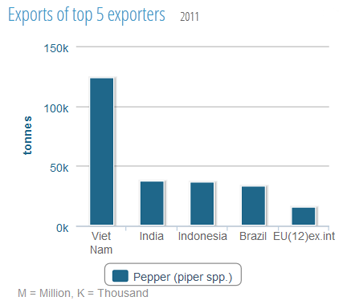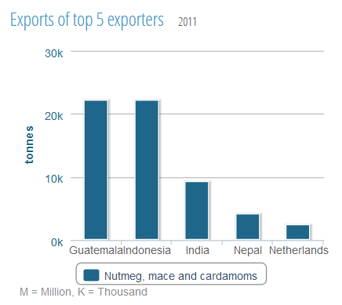New quality criteria to be developed for booming spice and herb sector
11 February 2014, Kochi, India/Rome - An international effort has been launched to develop quality standards for key products of the multi-billion dollar spice and herb trade.
The sector has been enjoying rapid growth for several decades on the back of burgeoning demand from the booming economies of Asia and elsewhere, and increased recognition of the health and culinary benefits of herbs and spices.
In response to the sector's growth and the extraordinary diversity of the trade and its products, the global food standards body the Codex Alimentarius Commission last year established the Codex Committee on Spices and Culinary Herbs (CCSCH). The first meeting of the CCSCH will be held in the southern Indian city of Kochi in Kerala state from 11-14 February.
The new Committee is hosted by India and is responsible for promoting worldwide quality standards for many of the most important spices and culinary herbs.

"By developing such standards, Codex wants to contribute to the safety, quality and fairness of the international spice and herb trade," Ren Wang, Assistant Director General of FAO's Agriculture and Consumer Protection Department said. "Once clear internationally accepted standards are established, consumers can trust the safety and quality of the spices and herbs they buy.
"Importers can trust that the spices and herbs they order and then have delivered will be in accordance with their specifications.
"Perhaps most importantly, the millions of smallholder farmers who grow spices and herbs for a living can see more clearly what they should be growing and to what standard," Wang said.
Established by FAO and WHO in 1963, Codex develops harmonized international food standards, guidelines and codes of practice to protect the health of the consumers and ensure fair practices in the food trade.

The Commission is already helping to regulate the safety of many spice and herb products - like all other foods - with its general standards for hygiene, contaminants, and pesticide residues. The new committee will be part of a continuing effort to establish quality standards at a global level for many of the world's most important spices such as black pepper, vanilla and nutmeg and herbs like rosemary, thyme and basil.
According to the FAO publication
Spices and Herbs for Home and Market, there are around fifty spice and herb plants of global trade significance, but many other spices and herb crops are expanding and offer good returns to small-scale farmers.
Spice and herb plants provide seeds and fruits, leaves and stems, flowers and buds, roots and rhizomes, bark and resins that can all be commercialized in various forms. Each of these products can then be sold fresh, frozen, dried, whole or ground, distilled into oils or solvents extracted into oleoresins.
With such a diverse range of by-products and uses, booming international demand and expanding areas of production, the need for international standards is clear. While there are standards for some spices and herbs already, there is no global body that provides product specific, harmonized quality standards for whole and ground spices and culinary herbs.

 "By developing such standards, Codex wants to contribute to the safety, quality and fairness of the international spice and herb trade," Ren Wang, Assistant Director General of FAO's Agriculture and Consumer Protection Department said. "Once clear internationally accepted standards are established, consumers can trust the safety and quality of the spices and herbs they buy.
"By developing such standards, Codex wants to contribute to the safety, quality and fairness of the international spice and herb trade," Ren Wang, Assistant Director General of FAO's Agriculture and Consumer Protection Department said. "Once clear internationally accepted standards are established, consumers can trust the safety and quality of the spices and herbs they buy.  The Commission is already helping to regulate the safety of many spice and herb products - like all other foods - with its general standards for hygiene, contaminants, and pesticide residues. The new committee will be part of a continuing effort to establish quality standards at a global level for many of the world's most important spices such as black pepper, vanilla and nutmeg and herbs like rosemary, thyme and basil.
The Commission is already helping to regulate the safety of many spice and herb products - like all other foods - with its general standards for hygiene, contaminants, and pesticide residues. The new committee will be part of a continuing effort to establish quality standards at a global level for many of the world's most important spices such as black pepper, vanilla and nutmeg and herbs like rosemary, thyme and basil.